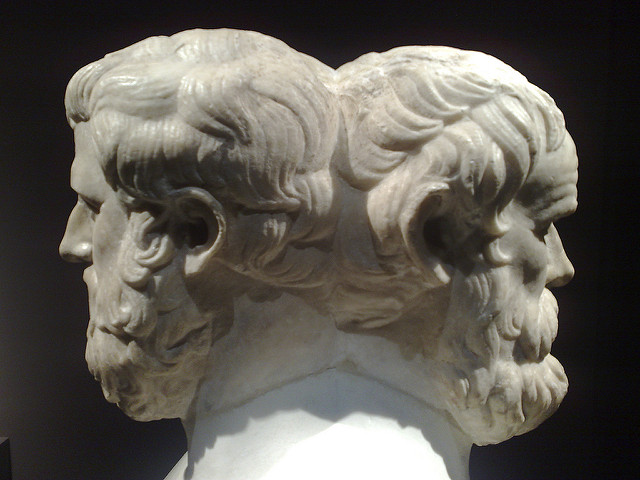
“A thing must be loved before it is loveable,” G. K. Chesterton once said.[1] Many of us want to know how we can become better people. We want to know how we can help our children and our students to become better people. Indeed, philosophers since Plato and Aristotle have been interested in how it is that people become virtuous, perhaps because, as Julia Annas puts it, “We cannot understand what virtue is without coming to understand how we acquire it.”[2] And although philosophers have largely ignored Chesterton’s insight,[3] he appears to have been exactly right, even prophetic.
Recent psychology suggests that an enormous factor in moral development—perhaps the great factor—is attachment. ‘Attachment’ is a fancy word for enduring love, the sort we see between parents and children, and in marriages and close friendships. None of us would want to live without such love. Few of us have ever lacked it completely, and the times we’re made to go without enough of it are oppressively painful, like going without sunlight or fresh air.
All of this is taken onboard by attachment theory, a research program in developmental psychology that aims at explaining the nature and significance of human attachments.[4] One of the major claims of attachment theory is that, through their early experiences with a caregiver, infants form an internal “map” of what they can expect from others. If, for instance, the caregiver is warm and attentive, the infant will write this down on his map. He will then use his map to go about future socializing. He will expect others to be warm and attentive. He will trust that, if he shows his needs to them, they will care. He will be, as the experts say, “securely attached”.
If, on the other hand, the caregiver is a lousy bum, the infant will expect others to be lousy bums. Perhaps he will decide that he had better rely on himself to get his needs met. He will be “insecurely attached”.
Of course, both the writing of the map and the using of it are unconscious processes, only entering consciousness as a whiff of anxiety here or a sigh of relief there. And this may sound like so much Freudian mysticism. But the “map” here is really just a stored mental representation, and it is by now commonplace that the brain unconsciously creates mental representations of how things are, that it uses these to make predictions, and that it begins to do so no later than when we come screaming into the world.[5]
Children who are securely attached have more of the stuff that virtues are made of. It is alarming, in fact. In a study from Jude Cassidy’s lab,[6] for example, researchers interviewed children using puppets (they say it’s for the kids). They ask the children questions that elicit self-reflection. They code their answers in one of three ways:
Perfect: No negative comments about the self at all.
Negative: Globally negative remarks about the self.
Flexible: Globally positive remarks about the self, mixed with specific negative remarks.
What they found? Securely attached children were more likely to talk about themselves in the flexible way. What this seems to suggest is that being securely attached means you are better able to love and respect yourself while admitting to specific ways you could improve.
It’s worth underlining this. Consider how important this ability is to personal growth. Indeed, one of the great challenges of human life is finding a way to admit one’s gruesome imperfections without being crushed by the shame of it. One meets many people who deal with this by only embracing one side of the dilemma. One tells the truth, and is crushed. Or one avoids the crushing but only through self-deceit. The trick is to tell the truth, the whole damn thing, without sentencing yourself to life without parole. (An analogous challenge arises when it comes to our love for others: How do we love them when we discover their vileness?)
The Cassidy study only scratches the surface. Here is a list of eleven other virtue-related areas where the securely attached are better off:[7]
- Self-worth[8]
- Realistic self-image[9]
- Emotion regulation[10]
- Cooperative problem solving[11]
- Self-reliance[12]
- Understanding of others’ needs and emotions[13]
- Understanding of one’s own needs and emotions[14]
- Acceptance of vulnerability[15]
- Resilience[16]
- Conscience development[17]
- Open and elaborative conversational style[18]
In light of this stunning list, it appears Chesterton was right: A thing must be loved before it is loveable. We must be loved before we are loveable. As Steinbeck writes, “underneath their topmost layers of frailty men want to be good and want to be loved. Indeed, most of their vices are attempted short cuts to love.”
One of the most sublime scenes in Peter Pan has Wendy telling the lost boys how she and her brothers came to the Neverland. The boys are concerned, though. Won’t their parents miss them? This is her response:
“If you knew how great is a mother’s love,” Wendy told them triumphantly, “you would have no fear. … You see,” Wendy said complacently, “our heroine knew that the mother would always leave the window open for her children to fly back by; so they stayed away for years and had a lovely time.”
Wendy, too, is prophetic. The world can be for us a Neverland, a place of enchantment and wonder, where good things run wild, only if we know there is someone who has left the window open for us.
There is a thorn in all this, given the many people who endure a fraught childhood followed by a lonely adulthood. Aristotle thought that it was through practicing the virtues that we acquire them. “We become just by doing just actions,” he says. Recently, Julia Annas has taken this up, drawing an analogy with learning the piano:
I need first to work out consciously what is the right thing to do and then get used to doing it over and over again. This goes on from learning notes to learning scales and arpeggios and then learning how to play sonatas. As I become a skilled piano player … I can play sonatas and other pieces in a way that, as with driving, proceeds without conscious thinking.[19]
Annas thinks acquiring virtues is like this, a view we might call the skill model. There is something right about the skill model, but something it leaves out as well. If you want to become virtuous, the research we’ve seen here suggests, not the practicing of the virtues, but the healing of the attachments. This is something done in therapy and by working towards healthy intimate relationships. Learning the virtues is like learning the piano, but many of us are playing with hands that have been broken and mangled. We do not need practice. We need rehab.
References
Annas, J., (2011), Intelligent Virtue, Oxford University Press.
Bowlby, J., (1980), Attachment and Loss, Vol. 3: Loss, Sadness, and Depression, New
York: Basic Books.
Cassidy, J., (1988), “Child-Mother Attachment and the Self in Six-Year-Olds”, Child
Development 59(1): 121-134.
Chesterton, G. K., (1909), Orthodoxy, New York: John Lane Company; London: John
Lane, The Bodley Head.
Clark, S., and D. Symons, (2000), “A Longitudinal Study of Mother-Child Relationships
and Theory of Mind in the Preschool Period”, Social Development 9(1): 3-23.
Colman, R., and R. Thompson, (2002), “Attachment Security and the Problem-Solving
Behaviors of Mothers and Children”, Merrill-Palmer Quarterly 48(4): 337-359.
Dykas, M., and J. Cassidy, (2011), “Attachment and the Processing of Social
Information across the Life Span: Theory and Evidence”, Psychological Bulletin
137(1): 19-46.
Fivush, R., Haden, C., and E. Reese, (2006), “Elaborating on Elaborations: Role of
Maternal Reminiscing Style in Cognitive and Socioemotional Development”,
Child Development 77(6): 1568-1588.
Goodvin, R., S. Meyer, R. Thompson, and R. Hayes, (2008), “Self-Understanding in
Early Childhood: Associations with Child Attachment Security and Maternal
Negative Affect”, Attachment and Human Development 10: 433-450.
Harcourt, E., (2013), “Attachment Theory, Character, and Naturalism”, Ethics in
Contemporary Perspective, Julia Peters (ed.), New York: Routledge.
Kobak, R., Cole, H., Ferenz-Gillies, R., Fleming, W., and W. Gamble, (1993),
“Attachment and Emotion Regulation during Mother-Teen Problem Solving: A Control Theory Analysis”, Child Development 64(1): 231-245.
Laible, D., and R. Thompson, (2000), “Mother-Child Discourse, Attachment Security,
Shared Positive Affect, and Early Conscience Development”, Child Development 71(5): 1424-40.
Laible, D., and R. Thompson, (1998), “Attachment and Emotional Understanding in
Preschool Children”, Developmental Psychology 34(5): 1038-1045.
LeDoux, Joseph, (1996), The Emotional Brain, New York: Simon & Schuster.
Mikulincer, M., and P. Shaver, (2012), “An Attachment Perspective on
Psychopathology”, World Psychiatry 11(1): 11-15.
Mikulincer, M., Shaver, P., and D. Pereg, (2003), “Attachment Theory and Affect
Regulation: The Dynamics, Development, and Cognitive Consequences of
Attachment-Related Strategies”, Motivation and Emotion 27(2): 77-102.
Narvaez, D., (2016), “Baselines for Virtues”, Developing the Virtues, J. Annas, D.
Narvaez, and N. Snow, Oxford University Press.
Oppenheim, D., and N. Koren-Karie, (2009), “Mother-Child Emotion Dialogues: A
Window into the Psychological Secure Base”, Stress and Memory Development: Biological, Social and Emotional Considerations, J. Quas and R. Fivush (eds.), Oxford University Press.
Pollak, S., (2011), “Mechanisms Linking Early Experience and the Emergence of
Emotions: Illustrations From the Study of Maltreated Children”, Current
Directions in Psychological Science 17(6): 370-375.
Raikes, H., Virmani, E., Thompson, R., and H. Hatton, (2013), “Declines in Peer Conflict
from Preschool through First Grade: Influences from Early Attachment and Social Information Processing”, Attachment and Human Development 15(1): 65-82.
Raikes, H., and R. Thompson, (2008), “Attachment Security and Parenting Quality
Predict Children’s Problem-Solving, Attributions, and Loneliness with Peers”,
Attachment and Human Development 10(3): 319-44.
Reese, E., (2002), “Social Factors in the Development of Autobiographical Memory: The
State of the Art”, 11(1): 124-142
Sroufe, L., (1983), “Individual Patterns of Adaptation from Infancy to Preschool”,
Minnesota Symposium on Child Psychology, Vol. 16, M. Perlmutter (ed.), University of Minnesota Press.
Sroufe, L., Fox, N., and V. Pancake, (1983), “Attachment and Dependency in
Developmental Perspective”, Child Development 54(6): 1615-1627.
Thompson, R., (2015), “The Development of Virtue: A Perspective from Developmental
Psychology”, Cultivating Virtue, N. Snow (ed.), Oxford University Press.
Thompson, R., (2000), “The Legacy of Early Attachments”, Child Development 71: 145-
152.
Waters, S., Virmani, E., Thompson, R., Meyer, S., Raikes, H., and R. Jochem, (2010),
“Emotion Regulation and Attachment: Unpacking Two Constructs and Their Association”, Journal of Psychopathology and Behavioral Assessment 32(1): 37-47
[1] Chesterton (1909), p. 89.
[2] Annas, (2011), p. 21.
[3] An important exception is Harcourt (2013).
[4] See, for instance, Bowlby (1980).
[5] LeDoux (1996), Ch. 7.
[6] Cassidy (1988).
[7] I’m offering here a laundry list. Naturally, some psychologists have developed more systematic views that incorporate data in this area; see, for instance, Narvaez (2016) and Thompson (2015).
[8] Colman and Thompson (2002); Goodvin et al. (2008); Sroufe (1983).
[9] Clark and Symons (2000); Dykas and Cassidy (2011).
[10] Kobak et al. (1993); Mikulincer et al. (2003) et al.; Waters et al. (2010).
[11] Raikes and Thompson (2008); Raikes et al. (2013).
[12] Sroufe et al. (1983); Thompson (2000).
[13] Laible and Thompson (1998); Pollak (2008).
[14] Openhaim and Koren-Karie (2009).
[15] Mikulincer and Shaver (2008).
[16] Colman and Thompson (2002).
[17] Kochanska et al. (2004); Laible and Thompson (2000)
[18] Fivush et al. (2006); Reese (2002).
[19] Annas (2011), p. 13.






